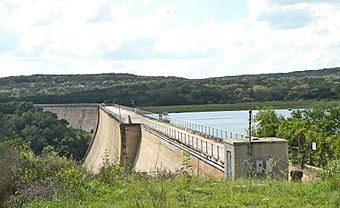Medina Dam facts for kids
|
Medina Dam
|
|

Medina Dam in 2010
|
|
| Nearest city | Castroville, Texas |
|---|---|
| Area | 4.1 acres (1.7 ha) |
| Built | 1911 |
| Built by | Fred Stark Pearson |
| NRHP reference No. | 76002050 |
Quick facts for kids Significant dates |
|
| Added to NRHP | March 15, 1976 |
The Medina Dam is a large dam in Mico, Texas, USA. It was built between 1911 and 1912 by the Medina Irrigation Company. The dam holds back the water of Medina Lake, which stretches into Medina County and Bandera County.
An American engineer named Dr. Frederick Stark Pearson designed and paid for the project. He got a lot of money from British investors to help build it. Over 1,500 workers built the dam, working 24 hours a day for two years. Most of them were skilled Mexican workers who had built other dams for Pearson. They earned two dollars a day, which was good pay back then. The company built a town called MICO (after the company's initials) for the workers and their families. This town is now known as Mico, Texas.
Contents
Building the Medina Dam
When the dam was finished in 1913, it was a huge achievement. It was the largest water engineering project west of the Mississippi River. It was also the fourth-largest dam in the entire United States. The dam is important for its role in developing the area. It is listed on the National Register of Historic Places. Building the dam was a very difficult and sometimes dangerous job for the workers.
Dam Size and Purpose
The Medina Dam is made of over 292,000 cubic yards (223,000 m³) of concrete. It stands 164 feet (50 m) high. At its base, it is 128 feet (39 m) wide, and it stretches 1,580 feet (482 m) long. The top of the dam is 25 feet (8 m) wide.
The dam helps water over 34,000 acres (138 km²) of farmland. These farms are in the Blackland Prairie area near Castroville, Texas. The dam also provides water to a treatment plant that supplies water to the San Antonio Water System.
Medina Lake: A Recreation Spot
The large lake behind the dam is called Medina Lake. It is a popular place for fun activities like boating and fishing. Water from the lake flows into the Medina River. There is also another small dam four miles downstream that helps direct the water.
For many years, the top of the Medina Dam was a one-lane road. It connected to County Road 260. In 1980, the road was closed to cars. A new road, County Road 264, was built instead.
Historical Markers at the Dam
There are three special historical markers on the dam. They tell important stories about the area. Currently, people cannot easily visit these markers.
1936 Mountain Valley Marker
The oldest marker was placed in 1936. It remembers a Mormon settlement called Mountain Valley. This settlement was built in 1854. It was later destroyed in 1913 when the dam was built. The old town of Mountain Valley is now under the waters of Medina Lake.
The marker says: "Established in 1854 by 16 families of Mormons under the leadership of Lyman Wight (1796-1858). They abandoned their homes and mills in 1858 as the result of Indian depredations. Their lands are now beneath the waters of Medina Lake. Erected by the State of Texas - 1936."
1978 Texas Historical Commission Marker
In 1978, the Texas Historical Commission placed another marker. This one officially named the dam a state historical landmark.
It tells how Henri Castro, who settled the area in the 1840s, dreamed of farms with water from the Medina River. Dr. Fred Stark Pearson made this dream come true. He convinced British investors to pay for the dam. The marker explains that the dam was the largest in Texas when it was finished in 1912. It also says that limestone from a nearby quarry was used to build the huge concrete structure.
The marker also shares a sad part of the story. In 1915, Dr. Pearson and his wife were traveling to England. Their ship, the "Lusitania," was sunk by a German submarine during World War I. They both died.
The dam brought new wealth to the area. Farmers could grow more crops like vegetables. Water and electricity became available to people in the countryside. In 1925, local voters created a special district to manage the dam and its water system.
1991 Texas Historic Civic Engineering Marker
A third marker was placed in 1991. It recognized the Medina Dam as a Texas Historic Civic Engineering Landmark. This shows its importance in engineering history.
Future of Dam Access
The Medina Lake Preservation Society is working to open the dam to the public again. If that's not possible, they hope to at least move the historical markers. This way, more people can see and learn from them.



